
|
 |
 |
 |
 |
 |
 |
 |
 |

|

Prof. Kim is awarded Laser Science Award from the Optical Society of Korea (Feb 15, 2024)

|
Prof. Kim was awarded the 3rd Laser Science Award from the Optical Society of Korea (OSK).
In order to recognize excellence in laser research, Laser Science Award was established by the Quantum Electronics Division of the OSK.
This year, the award recognizes Prof. Kim for his contribution to ultralow-noise optical frequency combs and their precision timing applications.
Founded in 1989, the Optical Society of Korea (OSK) is one of the leading academic societies in the field of optics and photonics, with more than 6000 members from universities, research institutes, and various industries.
|
Optical frequency comb-injected on-chip clock distribution network (CDN) is published at Nature Communications (April 24, 2023) and also highlighted at Nature Electronics (May 26, 2023)

|
Our work with Prof. Hayun Chung's group (Korea University) on femtosecond-precision electronic clock distribution in CMOS chips by injecting frequency comb-extracted photocurrent pulses is published at Nature Communications. A clock distribution network (CDN) is a ubiquitous on-chip element that provides synchronized clock signals to all different circuit blocks in the chip. To maximize the chip performance, today's CDN demands lower jitter, skew, and heat dissipation. We demonstrated femtosecond-precision distribution of electronic clocks using driver-less CDNs injected by photocurrent pulses. Femtosecond-level on-chip jitter and skew could be achieved for GHz-rate clocking of CMOS chips by combining ultralow comb-jitter, multiple driver-less metal-meshes, and active skew control. The elimination of clock drivers could significantly reduce on-chip heat dissipation from clock distribution as well. This work shows the potential of optical frequency combs for distributing high-quality clock signals inside high-performance integrated circuits, including 3D integrated circuits. This work was also featured in Research Highlights of May 2023 issue of Nature Electronics ("Chips with a pulse").
|
For further reading:
M. Hyun et al, "Femtosecond-precision electronic clock distribution in CMOS chips by injecting frequency comb-extracted photocurrent pulses," Nature Communications 14, 2345 (2023) 
S. Thomas, "Chips with a pulse," Nature Electronics 6, 330 (2023)
Prof Kim is awarded an Optica Fellow at CLEO 2023 (May 9, 2023)
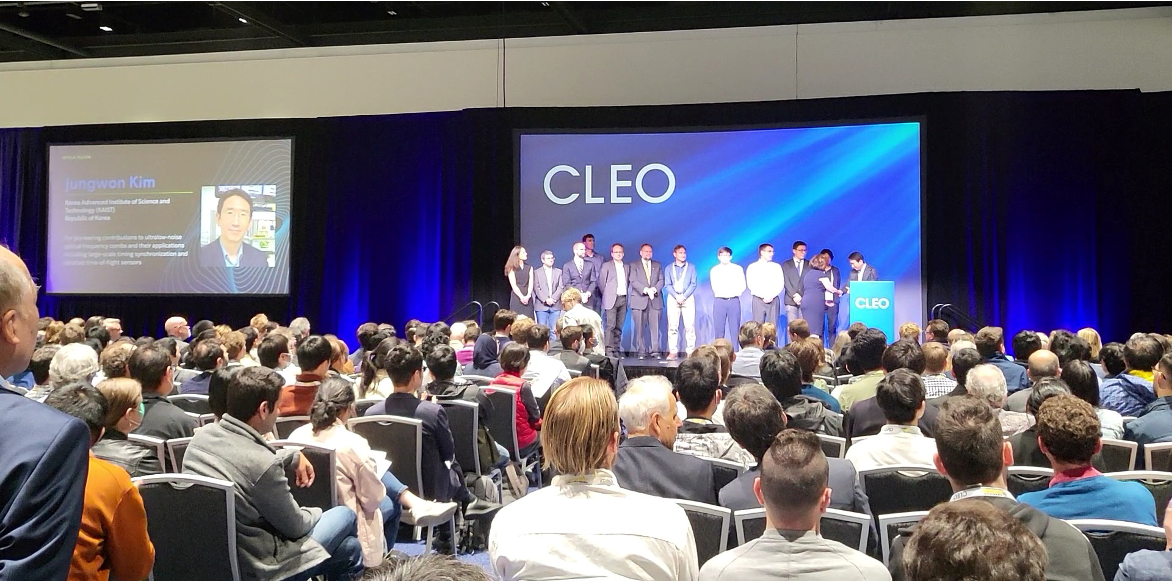
|
Prof. Kim has been elected as a Fellow of Optica and received the Optica Fellow plaque at CLEO 2023.
He was cited "For pioneering contributions to ultralow-noise optical frequency combs and their applications including large-scale timing synchronization and ultrafast time-of-flight sensors."
|
Founded in 1916, Optica (formerly Optical Society of America) is a leading organization in the science of light with global membership exceeding 24,000 worldwide. Fellows are nominated by their peers and selected based on several factors, including outstanding contributions to research, engineering, and service to Optica and the community, and the election process is highly competitive.
For further reading:
Optica Fellow Profile Page of Jungwon Kim
Ultrafast line-scan TOF camera for imaging structures and dynamics in micro-scale devices is published at Light: Science & Applications (Feb 15, 2023)

|
Our work on ultrafast line-scan TOF camera is published at Light: Science & Applications. High-speed and high-resolution imaging of surface profiles is critical for the investigation of various structures and mechanical dynamics of micro- and nano-scale devices. However, direct time-domain imaging of displacements and mechanical motions has been a missing element in studying full-field structural and dynamic behaviors. In this work, by exploiting the electro-optic sampling with a frequency comb, we demonstrate a line-scan TOF camera that can simultaneously measure the TOF changes of more than 1000 spatial coordinates with hundreds megapixels/s pixel-rate and sub-nanometre axial resolution over several millimeters field-of-view. This unique combination of performances enables fast and precise imaging of both complex structures and dynamics in three-dimensional devices and mechanical resonators.
|
For further reading:
Y. Na et al, "Massively parallel electro-optic sampling of space-encoded optical pulses for ultrafast multi-dimensional imaging," Light Sci. Appl. 12, 44 (2023)
Ultrastable microwave and soliton-pulse generation from a palm-sized photonic platform is published at Nature Communications (Jan 19, 2022)

|
Our work with Prof. Hansuek Lee's group on ultrastable microwave and soliton-pulse generation from a fiber-photonic-stabilized microcomb is published at Nature Communications. A compact yet high-performance stabilization method has been the missing ingredient for the field applications of microcombs. In this work, we demonstrate ultralow phase noise K-band microwaves by combining a silica microcomb (with a few mm diameter) and a fibre-photonic stabilizer (with a few cm diameter). Since the fibre-photonic stabilizer is compactly packaged in a palm-sized enclosure, our system can fully exploit the advantage of ultracompact microcombs while achieving ultrahigh microwave phase stability. The demonstrated method will be an enabling technology for a wide range of emerging applications with growing importance, including radio astronomy, photonic-radars, and 5G/6G telecommunications.
|
For further reading:
D. Kwon et al, "Ultrastable microwave and soliton-pulse generation from fibre-photonic-stabilized microcombs," Nat. Commun. 13, 381 (2022)
KAIST Press Release (in Korean): "KAIST generates ultrastable microwave signals by combining a photonic chip and an optical fiber"
We are joining the research collaboration effort between 5 national institutes for extreme-precision space-time measurements (Nov 24, 2021)

|
KAIST UPCaM joins the collaborative research effort that can greatly improve the spatio-temporal measurement precision through cooperation with National Geographic Information Institute (NGII), Korea Institute of Science and Technology Information (KISTI), Korea Astronomy and Space Science Institute (KASI), and Korea Research Institute of Standards and Science (KRISS). On November 24, the five organizations signed a memorandum of understanding (MOU) for Cooperation in Space-Time Convergence Research.
In this collaboration, we will work on the sampling/downconversion and microwave/millimeter-wave generation and detection with our ultralow-noise and compact frequency combs at VLBI telescope sites.
|
For further reading:
News article on the space-time convergence research effort at Donga Science (in Korean)
Igju Jeon is awarded Outstanding Paper Award from OSK Optics and Photonics Congress (Jul 7, 2021)

|
Our recent paper "Stable optical phase transfer over fiber links and microwave extraction for VLBIs" is awarded Outstanding Paper Award from Optical Society of Korea (OSK) Optics and Photonics Congress 2021 held in Jeju, Korea, Jul 5-7, 2021.
This work demonstrated a method for transferring stable optical phase through an optical fiber link from KRISS to KAIST and extracting stable microwave signals using frequency combs.
Congratulations Igju!
|
UED timing work appeared as the front cover paper of Laser and Photonics Reviews (Feb 11, 2021)
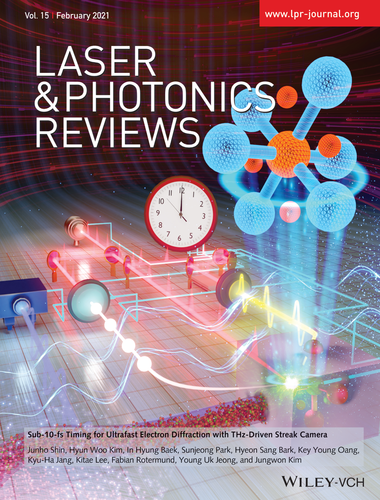
|
Our work with Korea Atomic Energy Research Institute (KAERI) on sub-10-fs timing for MeV-level ultrafast electron diffraction (UED) is published as a front cover paper of February 2020 issue of Laser and Photonics Reviews. An array of methodologies, including RF-to-laser synchronization, optical timing monitoring and electron dispersion control, is applied to enable THz-streaking with few-femtosecond resolution. With the THz-driven streak camera, timing of ultrafast electron bunch is stabilized to 5.5 fs in rms.
With high electron energy and low timing drift, the demonstrated capability is an important step toward studying ultrafast phenomena in samples with low scattering power, such as volatile gases and 2D materials.
|
For further reading:
J. Shin et al, "Sub-10-fs timing for ultrafast electron diffraction with THz-driven streak camera," Laser and Photonics Reviews 15, 2000326 (2021)
Front Cover of February 2021 issue of Laser and Photonics Reviews
Multilayer thickness metrology method is published at Light: Advanced Manufacturing (Jan 12, 2021)
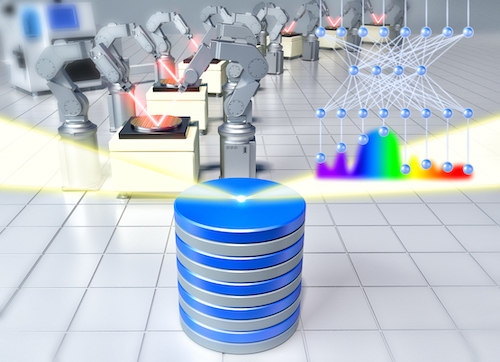
|
Our work with Samsung Electronics on a non-destructive thickness characterization method by combining optical spectral measurements and machine learning is published in an inaugural issue of Light: Advanced Manufacturing. The 3D-NAND is the most commercially successful 3D memory device today, and its demand is growing exponentially. As each layer thickness corresponds to the effective channel length, accurate characterization and control of layer-by-layer thickness is critical. For more than 200 layers of oxide and nitride multilayer stack, the thickness of each layer over the entire stack could be determined with an average of approximately 0.16-nm r.m.s. error. The method will provide new ways for total inspection in 3D semiconductor device manufacturing.
|
For further reading:
H. Kwak et al, "Non-destructive thickness characterisation of 3D multilayer semiconductor devices using optical spectral measurements and machine learning," Light: Advanced Manufacturing 2, 1 (2021)
phys.org news: "Angstrom multilayer metrology by combining spectral measurements and machine learning"
KAIST Press Release (in Korean): "KAIST developed a non-destructive thickness characterization method of 3D multilayer semiconductor devices with angstrom accuracy"
Prof. Kim is selected as the "Scientist of the Month" by Korean Ministry of Science & ICT (Oct 7, 2020)
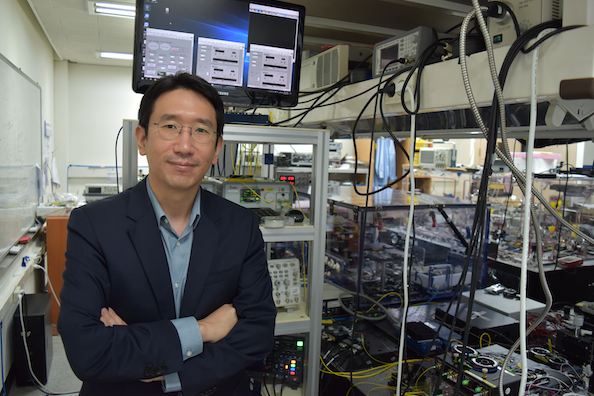
|
Prof. Kim is selected as the Scientist of the Month for October 2020, awarded by the Ministry of Science and ICT of Korean Government.
Since 1997, the "Scientist of the Month" Program has selected one researcher each month for the excellent R&D achievements in Korea. Prof. Kim was selected as the winner of this month in celebration of the ¡°Measurement Day (Oct 26)¡± commemorating King Sejong for establishing the measurement system for length and volume. Prof. Kim is cited for his contribution to broadening the horizon of precision engineering by developing ultrafast, ultrahigh-resolution, and multi-functional TOF sensor technology based on optical frequency combs.
|
For further reading:
Official announcement and interview by the National Research Foundation and Seoul Economy Daily (in Korean)
Few-fs-jitter soliton pulse train generation from a micro-comb is published at Optica (Aug 28, 2020)

|
Our work with Prof. Hansuek Lee's group on a few-fs-jitter, 22-GHz silica microresonator-based comb is published at Optica. Even micro-combs have theoretically predicted to achieve ultralow jitter, so far, the accurate characterization of timing jitter in micro-combs has been limited by the measurement methods. In this work, we showed that 2.6-fs rms timing jitter is possible for 22-GHz silica micro-combs. This jitter performance can greatly benefit many on-chip high-speed and high-bandwidth applications including analog-to-digital conversion, microwave generation, high-speed data links, and optical communications.
|
For further reading:
D. Jeong, D. Kwon et al, "Ultralow jitter silica microcomb," Optica 7, 1108-1111 (2020)
KAIST Press Release (in Korean): "KAIST developed a chip-scale ultralow-noise pulse source"
M. Erkintalo, "Got the quantum jitters," in News and Views of Nature Physics (2021)
Attosecond electronic pulse timing is published at Nature Communications (July 22, 2020)
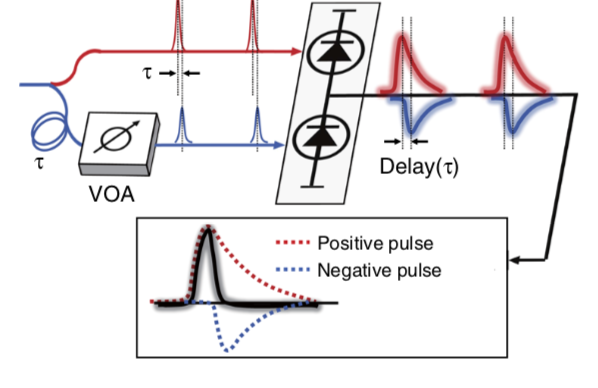
|
Our work on achieving tens of attoseconds timing with rising edges of photocurrent pulses is published at Nature Communications. In this work, we revealed that the residual jitter between optical pulses and rising edges of photocurrent pulses can be in the tens of attoseconds regime. The rising-edge jitter is much lower than the falling-edge jitter, and further, this ultralow rising-edge jitter could be obtained by both p-i-n and (modified-)uni-travelling-carrier photodiodes. This finding can be directly used for various edge-sensitive timing applications, and further shows the potential for ultrahigh-precision timing using silicon-photonic-integrable on-chip p-i-n photodiodes.
|
For further reading:
M. Hyun et al, "Attosecond electronic timing with rising edges of photocurrent pulses," Nat. Commun. 11, 3667 (2020)
KAIST Press Release (in Korean): "KAIST developed an electronic timing method with sub-femtosecond precision"
Multiple-comb stabilization to the quadrillionth level is published at Science Advances (Mar 27, 2020)
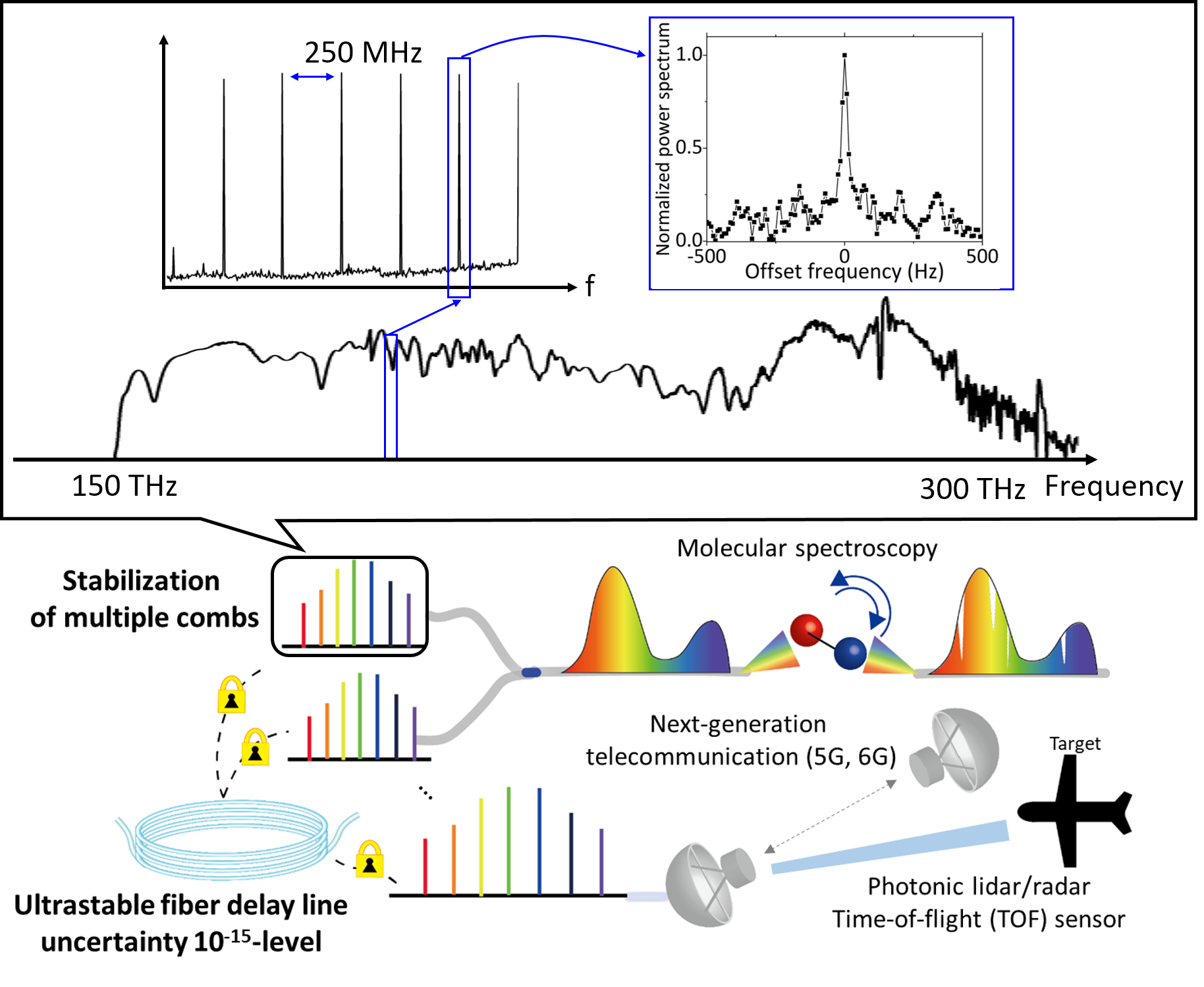
|
Our work on a simple, compact, alignment-free, and potentially low-cost all-fiber photonic platform for generating multiple ultra-stable optical frequency combs is published at Science Advances. Multiple combs with arbitrarily different repetition rates could be simultaneously stabilized to a compactly packaged 1-km-long standard telecommunication fiber spool with a diameter of only a few cm. The demonstrated method constitutes a mechanically robust and reconfigurable tool for generating multiple ultra-stable combs that are highly suitable for various high-precision field applications, including molecular spectroscopy, photonics-based RADARs and LIDARs, high-stability microwave generators for 5G and 6G telecommunication systems, and compact frequency stabilizer for atomic reference-based quantum sensors. |
For further reading:
D. Kwon et al, "Generation of multiple ultrastable optical frequency combs from an all-fiber photonic platform," Sci. Adv. 6, eaax4457 (2020)
KAIST Webzine Article ("Telecommunication optical fibers can stabilize the laser frequencies to the quadrillionth level")
Ultrafast and ultraprecise TOF detection method is published in Nature Photonics (Feb 10, 2020)
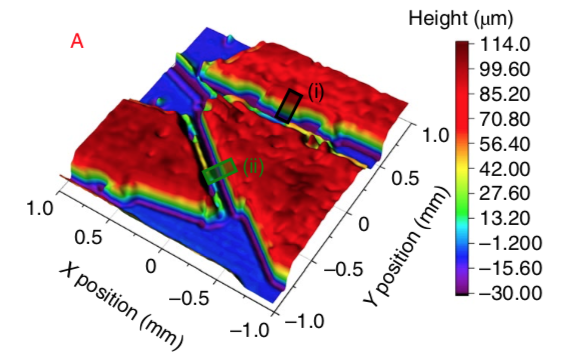
|
Our work on ultrafast, ultraprecise and multifunctional time-of-flight (TOF) detection method is published at Nature Photonics. By combining low-jitter mode-locked lasers and ultrasensitive electro-optic sampling-based timing detection method, we demonstrated a new class of TOF detection method that uniquely combines ultrafast measurement speed, sub-nm precision, and NAR of more than several mm. By using this TOF detection method, We could show multifunctional sensors including 3D surface profilometry and strain sensors. It further enables real-time detection of fast and high-dynamic-range mechanical displacements, facilitating the study of broadband and nonlinear mechanical dynamics in micro-scale devices. |
For further reading:
Y. Na et al, "Ultrafast, sub-nanometre-precision and multifunctional time-of-flight detection," Nat. Photon. 14 355 (2020)
KAIST Press Release (in Korean): "KAIST developed a new class of ultrafast and ultraprecise TOF sensor"
"Sensing at the limit" in Nature Research Collection (Jan 7, 2021)
A UED based on our laser-RF synchronization method is published in Nature Photonics (Dec 23, 2019)

|
An ultralow-jitter, MeV-level ultrafast electron diffraction (UED), based on our laser-RF synchronization method, is published at Nature Photonics. In recent years, UED has evolved to be a powerful tool for the study of structural dynamics with subpicosecond temporal resolution and subatomic spatial resolution. The Korea Atomic Energy Research Institute (KAERI) team developed an ultralow-jitter UED using a special RF photogun, wherein our laser-RF synchronization technique played an important role for its successful operation. As a follow-up study, we are currently working on drift-free operation of UED with sub-10-fs long-term stability as well.
|
For further reading:
H. Kim et al, "Towards jitter-free ultrafast electron diffraction technology," Nat. Photon. 14, 245 (2020)
H. Yang et al, "10-fs-level synchronization of photocathode laser with RF-oscillator for ultrafast electron and X-ray sources," Sci. Rep. 7, 39966 (2017)
Two Outstanding Paper Awards from OSK Summer Meeting 2019 (Jul 17, 2019)
 | 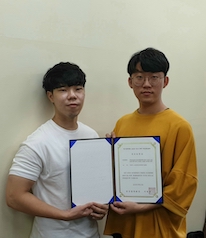
|
Hyunsoo Kwak's "Multilayer thickness metrology of 3D semiconductor devices" paper and Chan-Gi Jeon's "Low-noise repetition-rate multiplication with injection locking and gain-saturated SOA" paper are awarded Outstanding Paper Awards from Optical Society of Korea (OSK) Summer Meeting 2019 held in Busan, Korea, Jul 15-17, 2019.
Congratulations Hyunsoo and Chan-Gi!
|
Minji Hyun's paper is selected as Chairs' Pick Paper at CLEO 2019 (May 9, 2019)
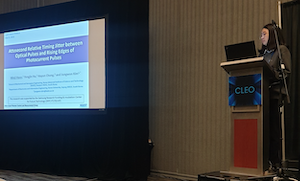
|
Our recent paper "Attosecond Relative Timing Jitter between Optical Pulses and Rising Edges of Photocurrent Pulses" is selected as Chairs' Pick Paper at CLEO 2019 held in San Jose, CA, USA in May 5-10, 2019.
This work demonstrated that the relative timing jitter between optical pulses and rising edges of photocurrent pulses can be sub-100-attosecond regime for the first time. Among >1500 accepted papers presented at CLEO 2019, 51 papers top-rated by the technical program committee are selected as Chairs' Pick papers. CLEO is one of the largest and highest-quality conferences in lasers and photonics with >4000 attendees every year.
Congratulations Minji!
|
Proposed research selected as large-sized NRF basic research project (Feb 23, 2018)

|
Our proposed research on femtosecond laser-based multi-sensors and imaging systems is selected as Mid-Career Research Type-3 Project (previously called as National Research Lab) of National Research Foundation of Korea (NRF), one of the most selective and largest-sized basic research grants for individual researchers in South Korea. For Phase 1 over the next 3 years, the proposed research aims at developing a new class of TOF sensor and imaging systems based on ultra-broadband optical spectra and ultra-low timing jitter of femtosecond lasers, which will open up new possibilities in physical sensors and LIDAR imaging.
|
Dohyun Kim is awarded Outstanding Paper Award from OSK Meeting (Feb 9, 2018)
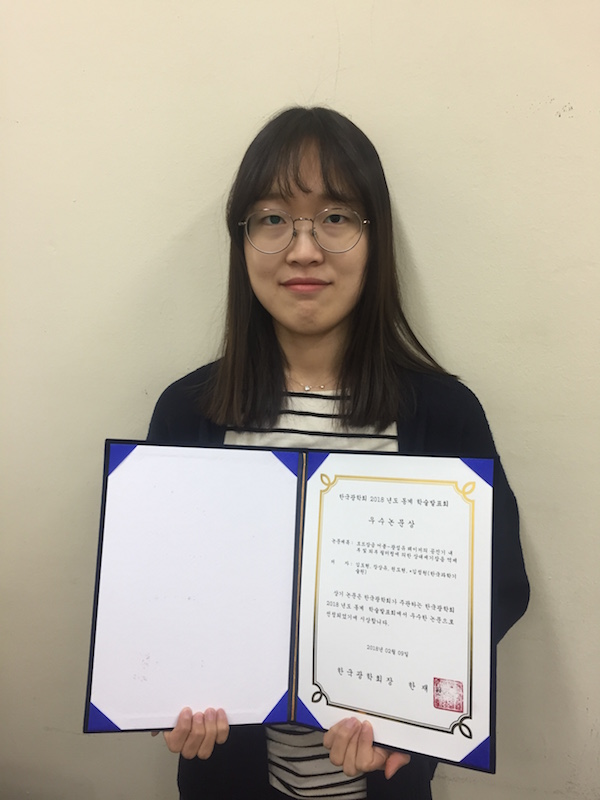
|
Our recent paper "Intensity noise reduction of mode-locked fiber lasers by double optical bandpass filtering" is awarded Outstanding Student Paper Award from Optical Society of Korea (OSK) Winter Meeting 2018 held in Gwangju, Korea, Feb 7-9, 2018.
This work demonstrated a simple method for lowering relative intensity noise (RIN) of mode-locked fiber lasers to one of the lowest levels demonstrated so far by intra- and extra-cavity optical bandpass filtering.
Congratulations Dohyun!
|
Prof. Kim is awarded Haelim Photonics Award from Optical Society of Korea (Feb 8, 2018)
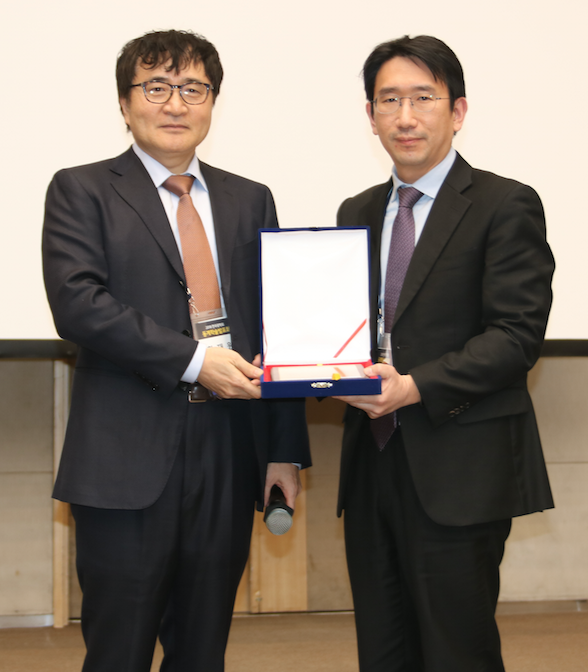
|
Prof. Kim was awarded the 8th Haelim Photonics Award from the Optical Society of Korea (OSK).
In order to recognize excellence in photonics research, Haelim Photonics Award was established by the generous donation from Prof. ''Haelim'' Un-Chul Baek (1934-2011), who was a world leader in the optical fiber manufacturing field.
This year, the award recognizes Prof. Kim for his contribution to ultralow-noise mode-locked fiber lasers and their applications in microwave photonics field.
Founded in 1989, the Optical Society of Korea (OSK) is one of the leading academic societies in the field of optics and photonics, with more than 6000 members from universities, research institutes, and various industries.
|
Proposed research selected as Samsung Future Technology Center Project (Sep 28, 2017)
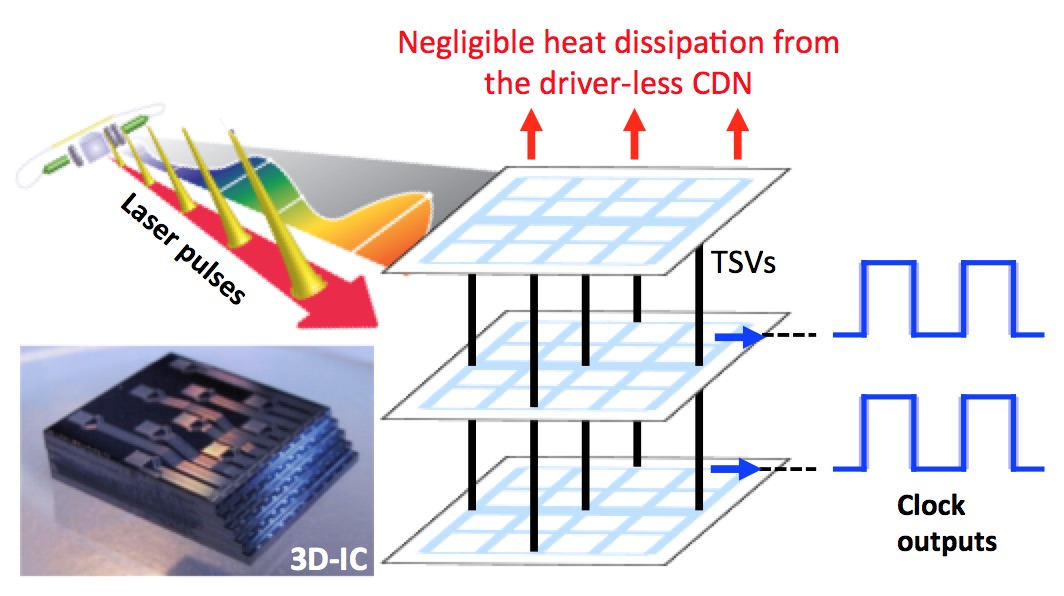
|
Our proposed research on femtosecond laser-based on-chip clock distribution network (CDN) is selected as the Creative ICT Project of Samsung Future Technology Center, one of the most selective and prestigious research grants in South Korea. Today's on-chip clocking requires lower jitter, lower skew, lower power, and higher PVT-variation-tolerance to maximize the chip performance. By using low-jitter and ultrashort optical pulses, this project will establish a new class of low-jitter, low-skew and low-power on-chip CDN technique, aiming at performance improvement from the previous state-of-the-arts by more than an order of magnitude.
|
Dr Chur Kim is awarded Outstanding PhD Thesis Award from KAIST ME (Sep 6, 2017)

|
UPCaM almunus Chur Kim (PhD '17) is awarded the Alumni Association Award (Outstanding PhD Thesis Award) from KAIST Department of Mechanical Engineering. Dr. Kim's doctoral research was concentrated on compact, low-noise and mechanically robust mode-locked laser sources. During his doctoral years, he published 4 journal papers and 8 conference papers as the first author and filed three patents (two Korean patents granted and one US patent pending). Upon graduation, he joined the Korea Electrotechnology Research Institute (KERI) as a Senior Researcher and continues his research on robust and high-power fiber laser systems for manufacturing and medical applications.
Congratulations Chur!
|
Prof. Kim published an invited review article at OSA's prestigious journal (Aug 30, 2016)
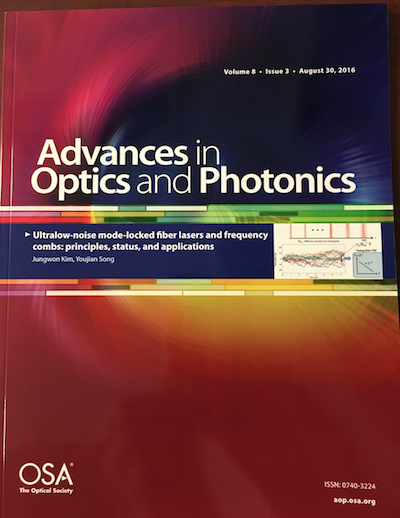
|
Prof. Kim, together with a former post-doc Youjian Song, published an invited review article on ultralow-noise mode-locked fiber lasers at Advances in Optics and Photonics (AOP). AOP is a prestigious review journal, published by Optical Society of America (OSA), that is designed to capture the most significant advances in optics and photonics from prominent authors at the forefront of their fields. Prof. Kim's 76-page-long paper comprehensively reviews the principles, implementations and applications of ultralow-noise mode-locked fiber lasers and frequency combs over the last 25 years. This paper has been one of the top 10 downloaded AOP articles for 5 months in a row (Sep 2016 - Jan 2017), and was also selected as one of the top downloaded articles in lasers and laser optics from AOP and OL in 2016. |
For further reading:
J. Kim and Y. Song, "Ultralow-noise mode-locked fiber lasers and frequency combs: principles, status and applications," Adv. Opt. Photon. 8, 465-540 (2016)
Prof. Kim is awarded 2015 KAIST Top 10 R&D Achievements Award (May 24, 2016)
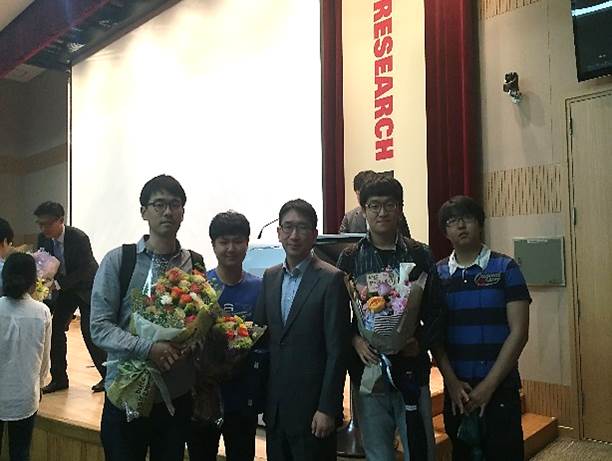
|
Our work on ultralow-noise fiber photonic oscillators was selected as one of the Top-10 R&D Achievements of KAIST in 2015. This work showed a low-cost and robust all-fiber photonic way to achieve world-class timing noise and stability, which can be readily applied in signal generators, scientific facilities, and defense systems. The prize was awarded at the annual KAIST Research Day ceremony held on May 24, 2016.
|
Junho Shin is awarded Outstanding Paper Award from OSK Meeting (Jan 22, 2016)

|
Our recent paper "Femtosecond-stability timing link stabilization method" is awarded Outstanding Student Paper Award from Optical Society of Korea (OSK) Winter Meeting 2016 held in Daejeon, Jan 20-22, 2016.
This work demonstrated the method for stabilizing timing links in a long-term stable way using PZTs and motorized stages. This research was performed by a collaboration with the Time-Frequency Center of Korea Research Institute for Standards and Science (KRISS).
Congratulations Junho!
|
Ultralow-noise all-fiber oscillator work was covered by national news media (Nov 12, 2015)
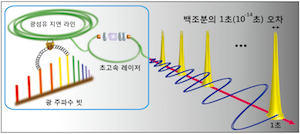
|
Our recent work on ultralow-noise, all-fiber photonic clock oscillators (K. Jung and J. Kim, "All-fibre photonic signal generator for attosecond timing and ultralow-noise microwave," Sci. Rep. 5, 16250 (2015)) was covered by major national news media including Chosun Ilbo, YTN, and Yonhap News. We showed a simple and robust way to suppress the phase noise of mode-locked lasers using all-fiber technology, which resulted in only 3-femtosecond absolute timing error accumulated in 0.1-s (which is the definition of timing jitter by ITU Standards). This result will find more applications in precision timing and synchronization, low-noise microwave synthesis, photonics radars, ranging, and optical communications in the near future.
|
For further reading:
Chosun Ilbo Article ("KAIST researchers developed an ultra-precise timing technology")
Yonhap News Article ("New fiber optic clocks show a millionth of a billionth of a second timing error.")
YTN TV News ("New fiber optic clocks show equivalent timing error of 1 second in one million years")
Chan-Gi and Kwangyun are awarded Outstanding Paper Awards from COOC (Jun 4, 2015)

|
A pair of papers entitled "Residual phase noise dependence on input power levels in FLOM-PD" (by Chan-Gi Jeon) and "Generation of fiber laser-based ultra-stable optical pulse trains" (by Kwangyun Jung) was each awarded Outstanding Student Paper Awards from Conference on Optoelectronics and Optical Communications (COOC) 2015 held in Busan, Jun 3-5, 2015.
Chan-Gi's work found the optimal condition to achieve the lowest residual phase noise in laser-microwave synchronization using FLOM-PD device. Kwangyun's work showed a new all-fiber-optic way to stabilize the repetition-rate of mode-locked fiber lasers.
Congratulations Chan-Gi and Kwangyun!
|
Junho Shin is awarded Poster Award from KAIST-Kyushu ME Workshop (Sep 26, 2014)
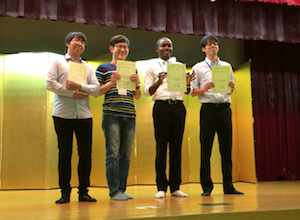
|
Master student Junho Shin was selected as one of four Outstanding Student Poster Award winners of the 7th KAIST-Kyushu University Joint Workshop on Frontiers in Mechanical and Aerospace Engineering 2014 held in Fukuoka, Japan, Sep 25-27, 2014.
Junho's work entitled "Laser-based technology for controlling accelerator-based light sources" showed the latest advances in achieving femtosecond-stability phase control of RF signals using short-pulse lasers in accelerator environment.
Congratulations Junho!
|
Prof. Kim delivered a tutorial lecture on frequency combs at OSK Meeting (Aug 25, 2014)
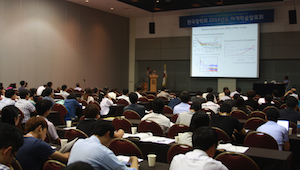
|
Prof. Kim delivered a special tutorial lecture on frequency combs at Optical Society of Korea (OSK) Annual Summer Meeting 2014 held in Jeju Island, Aug 25-27, 2014. The 2-hour lecture, entitled "Advanced Optical Frequency Combs and Their Ultrahigh-Precision Applications," covered various generation methods of frequency combs and their emerging applications ranging from optical atomic clocks to photonic radars, with more than 200 attendees.
|
Kwangyun Jung is selected as IEEE-IFCS Student Paper Competition Finalist (May 22, 2014)

|
PhD student Kwangyun Jung was selected as one of the Student Paper Competition Finalists of IEEE International Frequency Control Symposium (IFCS) 2014 held in Taipei, Taiwan, May 19-22, 2014.
Kwangyun's work entitled "Microwave transfer through optical frequency comb toward 10-19 instability using fiber-loop optical-microwave phase detector " showed a new way for high-precision microwave transfer, with an order of magnitude improved stability performance from the previous works. Kwangyun was a student paper competition finalist in IEEE-IFCS 2013 as well, where he presented a paper on attosecond-stability laser-microwave synchronization.
Congratulations Kwangyun!
|
Heewon Yang is awarded Outstanding Paper Award from OSK Meeting (Feb 20, 2013)
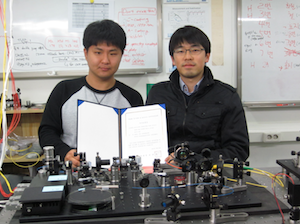
[Student authors of the paper, Heewon (left) and Chur (right)] |
Our recent paper "GHz repetition rate, diode-pumped Yb:KYW laser mode-locked by a CNT-coated mirror" is awarded Outstanding Student Paper Award from Optical Society of Korea (OSK) Winter Meeting 2013 held in Daejeon, Feb 18-20, 2013.
This work demonstrated the first GHz repetition rate solid-state laser mode-locked by a CNT saturable absorber.
This research was performed by a collaboration with Prof. Fabian Rotermund's group at Ajou University and Dr. Guang-Hoon Kim at KERI. The authors were Heewon Yang (PhD student), Chur Kim (PhD student), Sun Young Choi (PhD student at Ajou Univ), Dr. Guang-Hoon Kim, Prof. Fabian Rotermund and Prof. Jungwon Kim.
Congratulations Heewon and Chur!
|
Chur Kim is awarded Outstanding Paper Award from Photonics Conference (Dec 6, 2012)
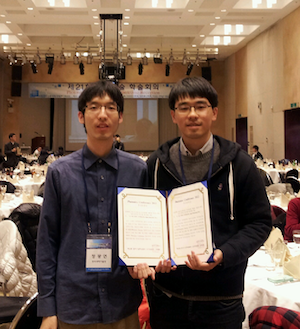
[Student authors of the paper, Kwangyun (left) and Chur (right)] |
Our recent paper "Timing jitter and intensity noise in CNT-mode-locked fiber lasers" is awarded Outstanding Student Paper Award from Photonics Conference 2012 held in Pyeongchang, Gangwon-Do, Dec 5-7, 2012.
This work demonstrated that low intensity noise and timing jitter can be obtained from a soliton all-fiber laser mode-locked by an evanescent-field-coupled CNT saturable absorber.
This research was performed by a collaboration with Prof. Khanh Kieu's group at the University of Arizona. The authors were Chur Kim (PhD student), Kwangyun Jung (PhD student), Prof. Khanh Kieu and Prof. Jungwon Kim.
Congratulations Chur and Kwangyun!
|
Prof. Jungwon Kim is elevated to Senior Member of IEEE and OSA (May 14, 2012)
Prof. Kim is elevated to the Senior Member grade of both the Institute of Electrical and Electronics Engineers (IEEE) and the Optical Society of America (OSA). The criteria for elevation to IEEE Senior Member is that the candidate has professional practice for at least 10 years and show significant performance over a period of at least 5 years, with 3 reference letters from current IEEE Fellows. The Senior Member grade is the prerequisite for being nominated as an IEEE Fellow.
The criteria for elevation to OSA Senior Member is that the candidate has at least 10 years of well-established professional accomplishment, with 2 reference letters from current OSA members.
Prof. Jungwon Kim is selected as the Ewon Assistant Professor (March 7, 2012)
Prof. Kim is appointed as one of the ten Ewon Assistant Professors at KAIST. The Ewon Assistant Professorship is founded to "promote young assistant professors with a significant potential to grow and perform creative teaching and research activities", following the wish of Mrs. Ewon Oh who donated a generous scholarship fund to KAIST in 2010. The appointment term is 3 years (March 2012-February 2015).
Record-low timing jitter result is highlighted in Nature Photonics (February 1, 2012)
For further reading:
N. Horiuchi, "Ultrafast photonics: Ultralow timing jitter" Nature Photonics 6, 71 (2012)
T. K. Kim et al, "Sub-100-as timing jitter optical pulse trains from mode-locked Er-fiber lasers," Opt. Lett. 36, 4443 (2011)
Y. Song et al, "Timing jitter optimization of mode-locked Yb-fiber lasers toward the attosecond regime," Opt. Express 19, 14518 (2011)
Hyoji Kim is awarded Outstanding Paper Award from Photonics Conference (Dec 2, 2010)

[Authors of the paper, Kwangyun, Hyoji, Jungwon, Youjian (from left to right), in front of the cross-correlator set-up] |
Our recent paper "Balanced Optical Cross-Correlators for the Timing Jitter Measurement of Ultrafast Yb-Fiber Lasers" is awarded Outstanding Student Paper Award from Photonics Conference 2010 held in Hoengseong, Gangwon-Do, Dec 1-3, 2010.
This work demonstrated a balanced cross-correlator working at 1-μm, which enabled the timing jitter characterization of Yb-fiber lasers with 24-attosecond (2.4×10-17 s) resolution over the full Nyquist frequency.
The authors are URP researcher Hyoji Kim, master student Kwangyun Jung, BK21 postdoctoral associate Youjian Song, and Professor Jungwon Kim, all members of UPCaM Group.
Congratulations Hyoji, Kwangyun and Youjian!
|
Recent work is featured on the cover page of Laser and Photonics Reviews (April 23, 2010)
A recent invited review article by the PI (J. Kim and F. X. Kaertner, "Attosecond-precision ultrafast photonics," Laser and Photonics Reviews 4, 432 (2010)) was selected as the "Editor's Choice" paper and highlighted on the cover page of the April 2010 issue of the journal. This paper outlines our recent progress toward attosecond-timing-precision photonics and its potential applications in high-precision signal generation, synchronization, distribution and characterization. It was also featured by Dr. Fuchs entitled "Ultra-precise and ultra-fast" on MaterialsViews.
Recent work is featured in Nature Photonics and optics.org (December 4, 2008)
A recent paper by the PI (J. Kim et al, "Drift-free femtosecond timing synchronization of remote optical and microwave sources," Nature Photonics 2, 733 (2008)) was highlighted in News and Views of Nature Photonics and in Research News of optics.org. This paper showed a breakthrough in long-term stable, long-distance synchronization of multiple lasers and electronic sources. The demonstrated techniques pave a way for high-precision clocking of large-scale scientific facilities including next generation light sources (X-ray free-electron lasers).
|
|
|
 |
|


